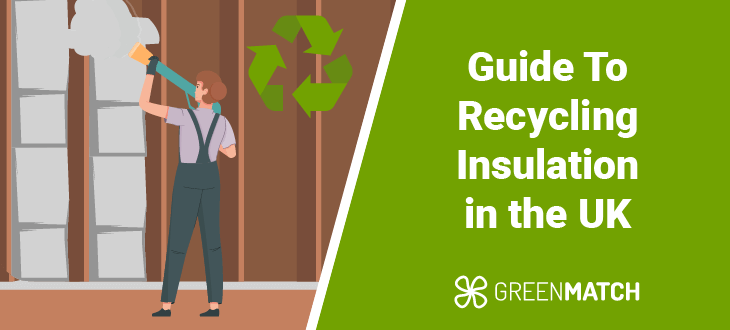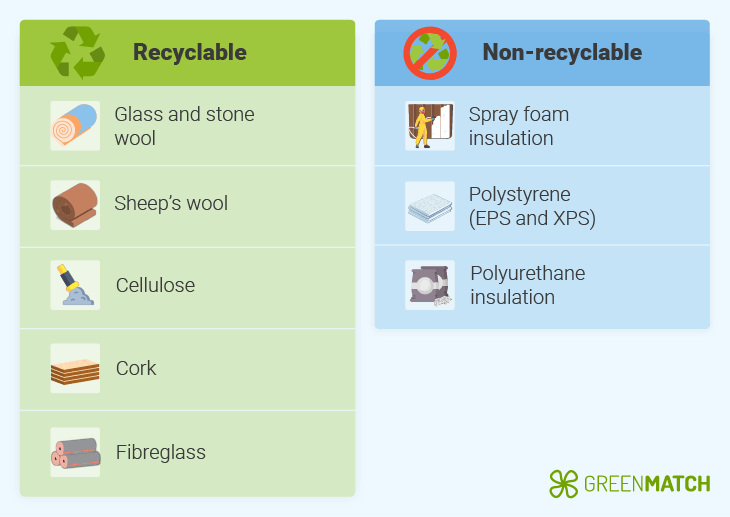Answer these simple questions and we will find you the BEST prices
Which type of solar quotes do you need?
It only takes 30 seconds
100% free with no obligation

Get Free quotes from insulation specialists near you

Save money by comparing quotes and choosing the most competitive offer

The service is 100% free and with no obligation
- GreenMatch
- Insulation
- Insulation Materials
- Recycle Insulation
How to Recycle Insulation in the UK


- To recycle insulation materials, follow local council waste guidelines, work with waste management companies, or use manufacturer take-back schemes.
- Recycling insulation significantly reduces landfill waste, lowers carbon emissions, and enhances energy efficiency.
- Replacing insulation in a typical UK home can save 620 kg of CO₂ annually and reduce heating bills by an average of £225 per year.
- Materials like glass wool, sheep's wool, and cellulose are recyclable, while spray foam and polystyrene can often not be recycled.
Recycling insulation is crucial in reducing waste, conserving resources, and enhancing your home’s energy efficiency. Whether upgrading your loft or replacing outdated materials, understanding how to recycle insulation effectively can save you money and benefit the environment.
This guide will help you understand which insulation materials can and cannot be recycled, providing clarity on the best choices for sustainability. It will outline practical steps to recycle insulation effectively in the UK, ensuring you comply with regulations while reducing waste. Additionally, you’ll learn how recycling insulation benefits you.
Recycling insulation doesn’t have to be complicated or costly. Let our trusted installers handle everything—from helping to recycle old insulation to installing energy-efficient alternatives. Fill in our quick form to receive up to 3 free quotes from local experts. Start saving money, energy, and the environment today!
- Describe your needs
- Get free quotes
- Choose the best offer
It only takes 30 seconds



Which insulation materials are recyclable?

Understanding which insulation types are recyclable and which are not can help you make informed decisions during construction or renovation projects. Several insulation materials can be recycled, reducing waste and promoting a circular economy:
- Glass and stone wool: These materials can be reclaimed and reprocessed after removing impurities like screws and nails. They are often incorporated into new insulation products or used in manufacturing processes.
- Sheep's wool: A natural, renewable resource, sheep's wool insulation is biodegradable and can be recycled. It requires minimal processing, reducing its carbon footprint.
- Recycled plastic insulation: Made from post-consumer plastic waste, this insulation diverts materials from landfills and limits the demand for new plastic production.
- Cellulose: Derived from recycled paper products, cellulose insulation repurposes waste materials and is treated with non-toxic fire retardants.
- Cork: Harvested sustainably from cork oak trees, cork insulation is renewable, biodegradable, and doesn't require trees to be cut down.
- Fibreglass: Fibreglass insulation can often be recycled at specialised facilities where it is cleaned, reprocessed, and reused in manufacturing. Its recyclability makes it an excellent choice for environmentally conscious projects.
Non-recyclable insulation materials
Some insulation materials pose challenges to recycling due to contamination or lack of facilities:
- Spray foam insulation: Once applied, spray foam insulation becomes rigid and adheres to surfaces, making it difficult to extract and recycle. It often ends up as waste.
- Polystyrene (EPS and XPS): While technically recyclable, polystyrene insulation is often contaminated during installation or use, limiting recycling options. Facilities capable of processing it are scarce.
- Polyurethane insulation: Polyurethane is challenging to recycle due to the energy-intensive processes required. Recycling programs do not widely accept it.
How to recycle insulation
Properly recycling old insulation benefits the environment and enhances your home's energy efficiency. Here's how you can responsibly manage insulation disposal in the UK:
- Check local council guidelines: Begin by consulting your local council's waste management policies. Many councils offer specific instructions for disposing of insulation materials, including designated recycling centres or collection services. Adhering to these guidelines ensures compliance with local regulations and promotes environmental responsibility.
- Use waste management companies: Professional waste management companies specialise in handling construction materials, including insulation. They possess the expertise to safely remove, transport, and recycle various insulation types. Engaging their services can simplify the process and ensure that materials are processed correctly.
- Contact insulation manufacturers: Some insulation manufacturers offer take-back schemes or recycling programs for their products. By reaching out directly, you can inquire about available options for returning old insulation, which may then be recycled into new products. This approach supports a circular economy and reduces waste.
- Repurpose and reuse: If the insulation is in good condition, consider repurposing it within your property. For example, leftover insulation can be used in sheds, garages, or other areas requiring thermal efficiency. Reusing materials not only saves money but also minimises environmental impact.
- Partner with specialist recycling facilities: Some recycling facilities specifically handle construction waste, including insulation. Research specialist centres in your region that accept materials like glass wool, stone wool, or polystyrene insulation. They have the necessary tools to process insulation for reuse or recycling.
- Consider donation: If your insulation is still in usable condition, some organisations or individuals may accept it for repurposing. Charities or community groups might use the material for smaller projects, reducing waste and benefiting those in need.
Is insulation recycling free?
While recycling insulation may not always be free, it offers long-term environmental and financial benefits by supporting sustainable practices and reducing landfill waste. Additionally, many UK councils, manufacturers, and waste services are working to make insulation recycling more accessible and affordable. Here’s a clear breakdown of when it might be free and where costs could arise:
- Professional removal services: Hiring experts to safely remove and handle old insulation can incur fees. For instance, removing loft insulation in a three-bedroom semi-detached property in the UK may cost around £700.
- Transportation and disposal fees: Transporting insulation to recycling facilities and the actual recycling process may involve charges. Some local recycling centres might accept certain types of insulation at no cost, but this varies by location and material type.
Ways to mitigate costs
- Manufacturer take-back schemes: Some insulation manufacturers offer programs to collect and recycle their products, potentially reducing disposal costs.
- Local council services: Check with your local council for any available services or guidance on insulation disposal, as they may offer cost-effective solutions.
- DIY removal: If it's safe and feasible, removing the insulation yourself can save on professional fees. Ensure you follow proper safety protocols and local regulations.
Why recycling insulation is important?

Recycling insulation materials is more than an eco-friendly option—it’s a practical choice that brings benefits to your home, finances, and the planet. By prioritising insulation recycling, you contribute to a sustainable future while optimising the efficiency and value of your property. Here’s why it should matter to you:
- Reducing environmental impact: Every year, thousands of tonnes of insulation waste end up in UK landfills, taking decades to decompose and contributing to environmental pollution. Recycling insulation materials conserves valuable resources and reduces carbon emissions. For example, loft insulation in a typical UK home can save 620 kg of CO₂ annually, making it a powerful tool for cutting your carbon footprint.
- Supporting a circular economy: Recycled insulation materials, such as glass wool and cellulose, are reprocessed into new products, reducing the need for raw materials like sand and oil. By supporting this circular approach, you’re directly helping the construction industry adopt more sustainable practices. Recycled products like PIR boards and cork boards are just as efficient as new ones, proving that sustainability doesn’t mean sacrificing quality.
- Lowering disposal and material costs: Recycling insulation isn’t just about waste reduction—it can also save you money. Some manufacturers offer take-back schemes for old insulation, reducing disposal fees, while recycled insulation materials are often cheaper than new ones. Additionally, reusing insulation within your property, such as in garages or loft spaces, provides a cost-effective way to reduce energy loss without buying new materials.
- Improving home energy efficiency: Upgrading to recycled, high-performance insulation can significantly enhance your home’s thermal performance. For instance, investing in loft insulation not only helps to retain heat but also saves an average of £225 per year on energy bills in a 3-bedroom home. This translates to a more comfortable living space with lower heating costs.
- Meeting UK waste regulations: Proper waste management is essential in the UK, where strict regulations govern the disposal of construction materials, including insulation. Recycling ensures compliance with these laws, avoiding potential fines while demonstrating ethical responsibility. This is especially important for contractors managing large-scale renovation projects.
- Contributing to long-term sustainability: By recycling insulation, you play a role in reducing resource depletion and waste generation. Natural materials like cork and sheep's wool insulation can be recycled multiple times, reducing their environmental impact. Choosing sustainable solutions today helps secure a healthier planet for future generations.
Ready to make a difference while saving on energy costs? Recycling and upgrading your insulation is easier than you think.
Fill in our quick form to get up to 3 free quotes from trusted local installers. Let the experts handle everything—from responsible disposal of old insulation to fitting energy-efficient, recycled alternatives. Take the first step towards a greener, more efficient home now!
- Describe your needs
- Get free quotes
- Choose the best offer
It only takes 30 seconds



FAQ
Yes, insulation material can be recycled depending on the type. Materials like glass wool, stone wool, cellulose, and recycled plastic insulation are commonly recyclable, while others, like spray foam, can be more challenging.
Old loft insulation can be recycled, reused, or safely disposed of. Check with your local council, contact a waste management company, or consider repurposing it in other areas like garages or sheds.
Yes, fibreglass can be recycled in the UK at specialist facilities. It is typically cleaned, processed, and reused in the manufacturing process of new products.

Nicole Bea Kerr is a content writer for Greenmatch, leveraging her experience in B2B journalism and editing. She is interested in bringing more awareness to sustainability through informative narratives.
We strive to connect our customers with the right product and supplier. Would you like to be part of GreenMatch?

- Describe your needs
- Get free quotes
- Choose the best offer
It only takes 30 seconds



